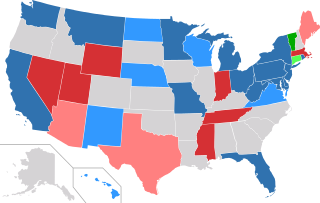United States Senate elections, 2012
| |||||||||||||||||||||||||||||
| |||||||||||||||||||||||||||||
| | |||||||||||||||||||||||||||||
| Senate Seats up for election: Democratic incumbent Retiring Democrat Independent incumbent Retiring Independent Republican incumbent Retiring Republican No Senate election | |||||||||||||||||||||||||||||
| |||||||||||||||||||||||||||||
| This article is part of a series on the 2012 US presidential election | ||
|---|---|---|
| | ||
| Republican primaries · candidates · debates | ||
| | ||
| Timeline · General election debates Additional races: House · Senate · gubernatorial | ||
Elections to the United States Senate are to be held on November 6, 2012, with 33 of the 100 seats in the Senate being contested in regular elections whose winners will serve six-year terms from January 3, 2013 until January 3, 2019. Additionally, special elections may be held to fill vacancies that occur during the 112th United States Congress. Currently, Democrats are expected to have 23 seats up for election, including 2 independents who caucus with the Democrats, while Republicans are expected to have only 10 seats up for election.
The 2012 presidential election, elections to the House of Representatives, elections for governors in 13 states and territories, and many state and local elections will also be held on this date.
Composition
Among the Senate seats up for election in 2012, there are 21 Democrats, 10 Republicans and 2 Independents. The Independents include Joe Lieberman, who ran and won as an independent in 2006 after losing the Connecticut Democratic primary. Lieberman and Independent Bernie Sanders of Vermont both caucus with the Democratic Party.
If Senators in other classes die or resign between 2011 and 2012, there may be additional special elections between the beginning of the 112th Congress (on January 3, 2011), and the 2012 election. The dates between which the death or resignation of a Senator would lead a special election during this time period vary from state to state.
Race summary
Predictions
Overview of races (33 seats)
Democrats/Independents retiring (6 seats)
Joe Lieberman of Connecticut (Independent)
Daniel Akaka of Hawaii
Jeff Bingaman of New Mexico
Kent Conrad of North Dakota
Jim Webb of Virginia
Herb Kohl of Wisconsin
Democrats who have not announced intentions
Dianne Feinstein of California
Ben Nelson of Nebraska
Democrats/Independents seeking re-election (15 seats)
Tom Carper of Delaware
Bill Nelson of Florida
Ben Cardin of Maryland
Debbie Stabenow of Michigan
Amy Klobuchar of Minnesota
Claire McCaskill of Missouri
Jon Tester of Montana
Bob Menendez of New Jersey
Kirsten Gillibrand of New York
Sherrod Brown of Ohio
Bob Casey, Jr. of Pennsylvania
Sheldon Whitehouse of Rhode Island
Bernie Sanders of Vermont (Independent)
Maria Cantwell of Washington
Joe Manchin of West Virginia
Republicans retiring (2 seats)
Jon Kyl of Arizona
Kay Bailey Hutchison of Texas
Republicans seeking re-election (8 seats)
Richard Lugar of Indiana
Olympia Snowe of Maine
Scott Brown of Massachusetts
Roger Wicker of Mississippi
Dean Heller of Nevada
Bob Corker of Tennessee
Orrin Hatch of Utah
John Barrasso of Wyoming
References
Retrieved from : http://en.wikipedia.org/w/index.php?title=United_States_Senate_elections,_2012&oldid=464769416


